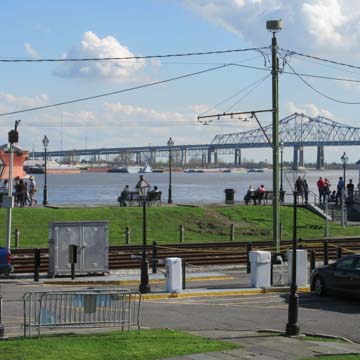For the city’s early settlers, the levee provided a scenic setting for public promenades, with the added advantage of cool breezes from the river. The English traveler Francis Bailey, who visited New Orleans in 1797, described it as “a handsome raised gravel walk planted with orange trees,” which “in the summer time served for a mall, and in an evening was always a fashionable resort for beaux and belles of the place.” “I have enjoyed many an evening’s promenade here,” he continued, “admiring the serenity of the climate and the majestic appearance of this noble river.”
In the nineteenth century, this land was increasingly occupied by wharves, industrial buildings, sugar sheds, warehouses, and railroad tracks. Esplanade Avenue and Canal Street replaced the levee as the site for casual perambulation. In the last quarter of the twentieth century, much of the levee fronting the Vieux Carré was returned to public use, the result of a public workshop convened in July 1972 by Cashio Cochran Sullivan and Wayne Collier, director of the Vieux Carré Commission. Improvements to Jackson Square were first (1976) followed by a redesign of Washington Artillery Park, and, on the levee, a wooden walkway with shade trees and benches overlooking the river, named the Moonwalk in honor of then-mayor (1970–1978) Maurice E. “Moon” Landrieu. Additional streetscape improvements (also by Cashio Cochran) were made to the adjacent French Market (OR6). In 1990, the twelve-acre Woldenberg Riverfront Park, with lawn, trees, and public art, was built upriver, extending over the river with lightweight soil on the concrete foundations that formerly supported warehouses.


